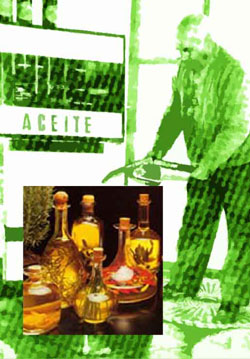In the area around Malaga, birthplace of Picasso, are villages scattered amongst the inland mountains referred to as the Aljapuras region.
Other specialties of this region include the famous snow-cured hams and the Costa wines, which are quite fine.
In Spain the main meal is served during the midday break, and can be quite extensive with lots of wine and brandy to wash the meal down. This of course calls for a typical siesta of two to three hours for recovery, before returning to work for the afternoon.
A typical meal here would perhaps include gazpacho or garlic soup with cured ham or patatas a lo pobre (sausages and potatoes fried together in guess what? – olive oil) as an appetizer or first course.
Heavy on the meats, the main course could offer the following: broad beans with ham or goat meat with a special marinade – choto a la cortijera. Side dishes are usually simple, but filling – gachas pimentonas is a porridge made with flour, water and vegetables or migas, which is fried bread crumbs with peppers and other chopped vegetables.
Desserts are rich and have a distinct Moorish influence here in the south of Spain. Typical offerings are almond puffs (soplillos), a cake called tarte de lata, candied pumpkin, anise flavored candies, rum babas called borrachillos, and a sponge cake called bizcochas.
Eating is an adventure in Andalucia, perhaps this is what inspired artists like Picasso and Dali with their fanciful visions. If I ate some of these things and had a few too many Sherries afterwards, I could also have visions of elephants with pyramids strapped on their backs dancing around with crutches amongst melted clocks.
Andalucia is also quite famous for its olive oil. Billions of olive trees in endless groves cover the mountains that back up the southern coast of Spain.
The Axarquian area inland from Marbella is where the town of Mondron offers arguably the best olive oil in Spain.
People say that King Juan Carlos himself has the oil from here on his table at every meal.
I remember seeing what I thought was a filling station for cars when driving thru the town one hot dusty afternoon, but to my amazement they were pumping green gold, the local olive oil, into barrels, drums, cans, jars, etc.
According to the local cooperative San Jose, they have been exporting this green gold liquid since the fourth century. It has been served at the tables of emperors for ages, and used by their ladies as a beauty lotion. To this day amphorae filled with olive oil are found in shipwrecks throughout the Mediterranean basin.
These olives are of the “verdial” variety, and are pressed in the traditional way, producing virgin olive oil of the highest quality. It is often praised for its low acidity, making it perfect for cosmetics and consumption.
Of course in summer, splashing some of this green gold on a salad with a squeeze of lemon juice is an amazingly refreshing lunch offering; try it with a bowl of gazpacho alongside.
By Martin Trip, Editor of the Hip Guides.

